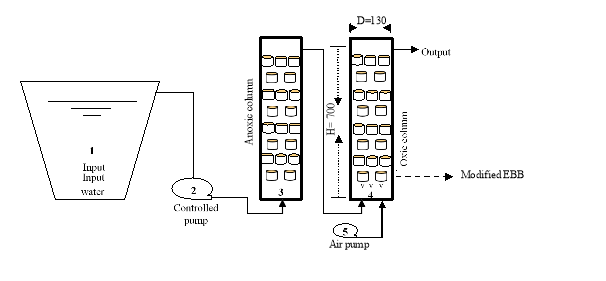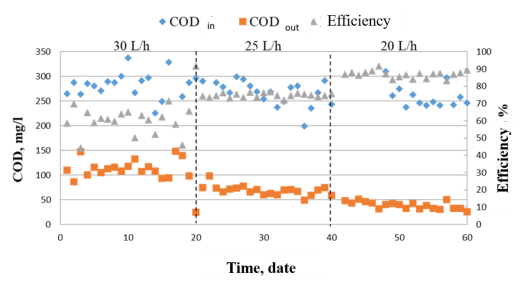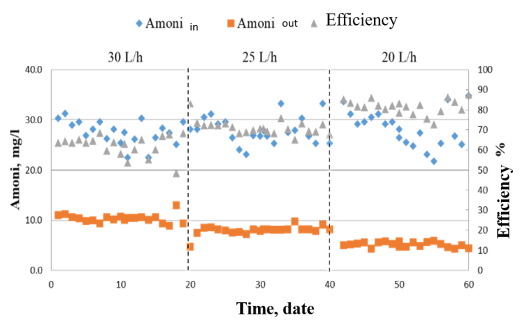This study investigates the removal performance of chemical oxygen demand (COD) and ammonium in obstetric clinic wastewater—a high-strength medical effluent rich in organic matter, nitrogen, and pathogenic microorganisms—using a modified Eco-Bio-Block (EBB). The modified EBB was fabricated from environmentally friendly components including activated carbon, keramzit (expanded clay aggregate), and zeolite, providing a porous structure with high surface area to enable simultaneous filtration, adsorption, and biofilm support. The EBB was installed in a compact IET-BF500 treatment system (0.5 m³/day capacity) configured with two compartments: an anoxic tank (150 L, containing 75 L of EBB) and an aerobic tank (200 L, containing 100 L of EBB). The system was operated continuously for 60 days, treating wastewater collected from an obstetric clinic in Hanoi with influent COD concentrations of 220÷340 mg/L and ammonium concentrations of 23÷32 mg/L. Results demonstrated that, under optimized hydraulic retention times, the system achieved COD removal efficiencies of 85–95 % and ammonium removal efficiencies of 81÷89 %, meeting or approaching the Vietnamese discharge standard QCVN 28:2010/BTNMT. Owing to its simplicity, low cost, and ability to maintain stable microbial populations, the modified EBB combined with an anoxic–aerobic configuration shows high potential for application in small-scale healthcare facilities and decentralized treatment systems, with the possibility of integrating advanced polishing technologies to address residual pharmaceuticals and antibiotic-resistant bacteria in medical wastewater.
Keywords: Modified Eco-Bio-Block, Obstetric clinic wastewater, Anoxic–aerobic process, COD removal, Ammonium removal, Decentralized wastewater treatment, Biofilm carrier.
Introduction
According to the 2019 Vietnam Population and Housing Census, the country’s total fertility rate was 2.09 children per woman, approaching the replacement fertility level. The census also reported that more than 1.2 million women of reproductive age accounted for 1.3 % of the total population and 5.0 % of all women in the same age group [1].
Compared with other types of healthcare wastewater, obstetric clinic effluents are characterized by both high pollutant loads and elevated concentrations of contaminants. These effluents contain a wide range of complex and hazardous substances, including pharmaceutically active compounds (PhACs) and their residues, endocrine-disrupting chemicals, hormones, heavy metals, disinfectants, dyes, cytotoxic agents, and radioactive isotopes [2]. Key physicochemical parameters such as biochemical oxygen demand (BOD), chemical oxygen demand (COD), total dissolved solids (TDS), total suspended solids (TSS), total solids (TS), total organic carbon (TOC), total nitrogen (T-N), nitrite, nitrate, and total phosphorus (T-P) are often recorded at high levels [3].
Obstetric clinic wastewater mainly originates from gynecological examination and treatment activities, including blood, pus, postpartum fluids, and medical instrument washing water. This wastewater contains diverse pathogenic microorganisms—bacteria, viruses, protozoa, fungi—as well as antibiotic-resistant bacteria (ARB), with common strains such as Escherichia coli , Enterococcus , Enterobacter sakazakii , Mycobacteria , and Pseudomonas aeruginosa [4]. These pathogens have been associated with serious outbreaks of diseases such as cholera, hepatitis, typhoid fever, dysentery, and diarrhea [5].
Selecting appropriate treatment technologies for medical wastewater, and particularly for obstetric clinic effluents, is an urgent issue—especially in the context of the rapid increase in the number of private clinics.
Eco-Bio-Block (EBB) is a versatile material in environmental treatment, originally developed in Japan and widely applied in Japan, the United States, Malaysia, and other countries. Its treatment principle relies on the activity of microorganisms immobilized within a porous honeycomb-like structure, providing a large specific surface area for biofilm development and enabling continuous removal of pollutants. Numerous international studies have demonstrated the efficiency of EBB in removing organic matter and nitrogen from wastewater [6].
The Institute of Science and Technology for Energy and Environment (Vietnam Academy of Science and Technology) has developed a modified EBB with combined filtration, adsorption, and biofilm carrier functions. The novelty of this material lies in the optimized blend of additives (activated carbon, keramzit, zeolite, etc.) with precisely controlled proportions, producing a lightweight, highly porous material with strong compressive strength and durability suitable for Vietnam’s climatic conditions [7].
Table 1
Mixing ratios of materials for producing the modified EBB
|
Porosity (%) |
Material composition | ||||
|
Sand content (%) |
Keramzit content (%) |
Cement content (%) |
Activated carbon content (%) |
Zeolite content (%) | |
|
64 |
14 |
36 |
14 |
14 |
22 |
Table 2
Technical specifications of the modified EBB
|
Parameter |
Unit |
Specification |
|
Shape |
- |
Cylindrical, hexagonal |
|
Dimensions |
mm |
80 × 40 × 60 |
|
Compressive strength |
N/cm 3 |
2,3 |
|
Specific surface area |
m 2 /gr |
≥ 200 |
|
Bulk density |
g/cm 3 |
0,3 |
|
Porosity |
% |
≥ 40 |
|
Microbial density |
CFU/gr |
10 5– 10 7 |
At present, biofilm carriers widely used in wastewater treatment systems in Vietnam are typically manufactured from recycled plastics, such as corrugated media, spherical media, and fiber media. These products require complex processing and manufacturing steps, which generate exhaust gases and wastewater, causing negative environmental impacts.
In contrast, the modified Eco-Bio-Block (EBB) is an environmentally friendly fixed biofilm carrier capable of rapidly removing organic matter and nutrients from water, while inhibiting most harmful bacteria and significantly reducing odors [8]. Its most notable advantage is the ability to accelerate system start-up through the combined adsorption, absorption, and filtration mechanisms of activated carbon, keramzit, and zeolite. Moreover, the EBB’s porous and relatively uniform structure allows for the long-term retention of microbial populations. With this approach, integrating the modified EBB into the IET-BF500 system for the treatment of medical wastewater in general—and obstetric clinic wastewater in particular—is essential, offering an effective option in the selection of innovative technologies in the energy and environmental sectors.
Materials and Methods
Materrials
In this study, wastewater samples were collected from an obstetric specialty clinic in Hanoi. The characteristics of the wastewater are summarized in Table 3.
Table 3
Characteristics of wastewater from the obstetric specialty clinic — Hanoi
|
Parameter |
Unit |
Concentration |
|
COD |
mg/L |
350 ÷ 400 |
|
N-NH 4 + |
mg/L |
40 ÷ 50 |
|
NO 3 - |
mg/L |
13 ÷ 15 |
|
NO 2 - |
mg/L |
6 ÷ 8 |
|
BOD 5 |
mg/L |
125 ÷ 170 |
|
SS |
mg/L |
267 ÷ 302 |
The modified Eco-Bio-Block (EBB) used in this study had a porosity of 64 %, a compressive strength of 2.3 N/cm², and a specific surface area of 200–210 m²/g. In addition, the microbial preparation Sagi–Bio2, produced by the Institute of Science and Technology for Energy and Environment, was selected to enhance biological treatment performance. This preparation contains beneficial microbial strains of Bacillus, Lactobacillus, and Saccharomycete, with a viable cell density exceeding 10⁸ CFU/mg [9]. The detailed experimental setup and procedure are illustrated in Figure 1.

Fig. 1. Schematic diagram of the IET-BF500 obstetric clinic wastewater treatment system
Wastewater is first directed into the collection tank (1), where preliminary sedimentation occurs. It is then pumped into the anoxic tank (3) via the dosing pump (2). In this compartment, facultative microorganisms attached to the modified EBB media degrade a portion of the pollutants present in the wastewater. Under low-oxygen conditions, anaerobic and anoxic microorganisms are highly active, facilitating the rapid denitrification of nitrate into free nitrogen gas. In the aerobic tank (4), continuous aeration promotes the activity of aerobic microorganisms, which intensively degrade organic compounds into simpler inorganic substances such as CO₂ and water, while further removing residual organic matter, nitrogen, and phosphorus from the wastewater.
Methods
Material preparation:
A total of 175 liters of raw modified Eco-Bio-Block (EBB) media was rinsed with clean water for 1 hour to remove adhering dust and impurities. The media was then drained and soaked in a 5 % glucose solution for 2 hours to provide a nutrient-rich environment for microbial attachment, thereby accelerating the start-up of the IET-BF500 treatment system.
System start-up:
The modified EBB was loaded into the anoxic compartment (75 L) and the aerobic compartment (100 L). Wastewater was recirculated with influent COD and ammonium concentrations ranging from 167–230 mg/L and 30–40 mg/L, respectively. After 48 hours of start-up, the system was operated sequentially at three flow rates: 30 L/h, 25 L/h, and 20 L/h, with each condition maintained for 20 days.
Sampling and analysis:
Effluent samples were collected daily for COD and ammonium analysis. Ammonium was measured using the sodium nitroprusside method at a wavelength of 655 nm with a UV–VIS spectrophotometer (Model UV-2450, Shimadzu, Japan). COD was determined using the dichromate method, with K₂Cr₂O₇ as the oxidizing agent [10].
Results and Discussion
COD Removal Performance

Fig. 2. COD removal efficiency in the IET-BF500 system
The COD removal performance of the IET-BF500 system is presented in Figure 2. Results show a clear improvement in treatment efficiency with increased hydraulic retention time (HRT) and decreased influent flow rate.
In Stage 1 (30 L/h, HRT = 5 hours), influent COD concentrations ranged from 220 to 340 mg/L, with average effluent concentrations of 120 ± 25 mg/L, corresponding to a removal efficiency of 57 ± 8 %. The relatively low performance at this stage is likely due to insufficient contact time between the wastewater and the biofilm on the EBB media, limiting both microbial degradation and physical–chemical adsorption.
In Stage 2 (25 L/h, HRT = 7 hours), COD removal efficiency increased to 74 ± 5 %, with influent concentrations of 215–310 mg/L and effluent concentrations of 70 ± 15 mg/L. This improvement is attributed to extended retention time, which allowed for more complete microbial degradation and adsorption processes.
Stage 3 (20 L/h, HRT = 8.8 hours) achieved the highest COD removal efficiency of 90 ± 3 %, with average effluent COD concentrations reduced to 35 ± 10 mg/L. This level of treatment meets the QCVN 28:2010/BTNMT, column A standard for COD in medical wastewater.
The ammonium removal performance in this study is comparable to results reported in other biofilm-based treatment systems. For instance, [11] found that longer retention times significantly enhanced ammonium removal in Vietnamese hospital effluents. Moreover, [12] reported that optimized biofilm-mediated reactors could sustain ammonium removal above 85–90 % in nitrogen-rich wastewater streams, supporting our findings of Stage 3 performance.
Moreover, [13] emphasized that hospital effluents often contain pharmaceutical residues—including antibiotics—that are inadequately removed by conventional treatment systems. Their study revealed significant environmental dissemination of such compounds into receiving waters, underscoring the need for advanced technologies like biofilm-based systems for comprehensive organic contaminant removal. This supports the relevance of our results, highlighting that the IET-BF500 system not only reduces COD effectively but also could help mitigate emerging micropollutants present in medical wastewater.
Overall, the COD removal trends observed in this study align with global research, confirming that extended HRT and adequate biofilm support media volume are critical for achieving high organic matter removal efficiency in healthcare wastewater treatment.
Ammonium Removal Performance

Fig. 3. Ammonium removal efficiency in the IET-BF500 system
The ammonium removal efficiency of the IET-BF500 system is shown in Figure 3. The results demonstrate a progressive improvement in performance as the hydraulic retention time (HRT) increased and the influent flow rate decreased.
In Stage 1 (30 L/h, HRT = 5 h), influent ammonium concentrations ranged from 23 to 32 mg/L, with effluent concentrations of 9÷13 mg/L, corresponding to an average removal efficiency of 60 ± 5 %. The relatively low performance at this stage can be attributed to insufficient contact time and limited nitrification activity under short HRT conditions.
In Stage 2 (25 L/h, HRT = 6 h), influent ammonium ranged from 24 to 34 mg/L, while effluent concentrations decreased to 5÷10 mg/L, achieving an average removal efficiency of 72 ± 4 %. This result meets the Vietnamese standard QCVN 28:2010/BTNMT, column B for ammonium in medical wastewater.
In Stage 3 (20 L/h, HRT = 7.5 h), influent ammonium averaged 55 mg/L, while effluent concentrations averaged 5 ± 1 mg/L, corresponding to a removal efficiency exceeding 85 %. This nearly met the more stringent QCVN 28:2010/BTNMT, column A standard. The significant improvement in Stage 3 highlights the importance of extended HRT for supporting nitrifying bacterial activity and maximizing ammonium oxidation.
The ammonium removal performance in this study is comparable to results reported in other biofilm-based treatment systems. For example, [11] reported removal efficiencies of 80÷88 % for hospital wastewater using moving bed biofilm reactors (MBBRs) at HRTs above 7 h. Additionally, a recent study by [14] (2024) on Vietnamese hospital wastewater treatment highlighted the importance of system configurations that meet local regulatory standards. Their results showed that systems designed with retention times of 7÷9 hours and optimized aeration can achieve both organic and nitrogen removal effectively. This reinforces our findings in Stage 3 (HRT ≈ 7.5 hours) where the IET-BF500 nearly meets stringent discharge limits, confirming its suitability for decentralized treatment applications in Vietnam.
Together, these findings demonstrate that the IET-BF500 system with improved EBB media not only delivers comparable efficiencies to international technologies but also holds strong potential for real-world application in Vietnamese healthcare settings.
Conclusion
This study evaluated the performance of the IET-BF500 system incorporating improved Eco-Bio-Block (EBB) media for the treatment of obstetric clinic wastewater. With the EBB media occupying 50 % of the reactor volume, the system achieved COD removal efficiencies of 85–95 % and ammonium removal efficiencies exceeding 85 % under optimized operational conditions. The findings demonstrate that the integration of improved EBB media provides several advantages, including rapid system start-up, stable long-term operation, low maintenance requirements, and environmental friendliness.
The system’s modular design allows for easy installation and scalability, making it well-suited for decentralized treatment of high-strength healthcare wastewater, particularly from obstetric clinics. However, to address residual pharmaceuticals and pathogenic microorganisms commonly present in medical effluents, future configurations of the IET-BF500 should integrate advanced post-treatment processes such as ozonation, coagulation–sedimentation, or photocatalysis.
Overall, the results confirm that the improved EBB media-based IET-BF500 system is a practical, cost-effective, and sustainable solution for the simultaneous removal of organic matter and nitrogen from medical wastewater in Vietnam and potentially in similar contexts worldwide.
Acknowledgements
The authors gratefully acknowledge the financial support provided by the Vietnam Academy of Science and Technology (VAST) under project code UD.SXTN.02/24–25. The authors also wish to express their sincere thanks to the staff of the Institute of Energy and Environmental Technology for their invaluable technical assistance and to the obstetric clinic in Hanoi for providing access to wastewater samples. The constructive comments from colleagues and reviewers are also deeply appreciated, as they have significantly improved the quality of this work.
References:
- General Statistics Office. Current situation and factors affecting fertility rates in Vietnam / General Statistics Office. — Hanoi: Ministry of Planning and Investment of Vietnam, 2021. — 117 c. — Текст: непосредственный.
-
M. T. Khan, I. A. Shah, I. Ihsanullah, M. Naushad, S. Ali, S. H. A. Shah, A. W. Mohammad. Hospital wastewater as a source of environmental contamination: An overview of management practices, environmental risks, and treatment processes, Journal of Water Process Engineering, Volume 41, 2021, 101990, ISSN 2214–7144, https://doi.org/10.1016/j.jwpe.2021.101990.
- Majumder, A. K. Gupta, P. S. Ghosal, M. Varma. A review on hospital wastewater treatment: A special emphasis on occurrence and removal of pharmaceutically active compounds, resistant microorganisms, and SARS-CoV-2. Journal of Environmental Chemical Engineering, Volume 9, Issue 2, 2021. 104812. ISSN 2213–3437. https://doi.org/10.1016/j.jece.2020.104812.
- V. K. Parida, D. Sikarwar, A. Majumder, A. K. Gupta. An assessment of hospital wastewater and biomedical waste generation, existing legislations, risk assessment, treatment processes, and scenario during COVID-19. Journal of Environmental Management, Volume 308, 2022, 114609, ISSN 0301–4797, https://doi.org/10.1016/j.jenvman.2022.114609.
- S. Wu, J. Zhong, Q. Lei, H. Song, S.-F. Chen, A. Q. Wahla, K. Bhatt, Sh. Chen. New roles for Bacillus thuringiensis in the removal of environmental pollutants, Environmental Research, Volume 236, Part 1, 2023, 116699, ISSN 0013–9351, https://doi.org/10.1016/j.envres.2023.116699.
- Mohd BR, Shahabuddin M, Mohd IMM (2008), Water quality improvement of Sungai Kenawar Segamat (prototype test site) using eco bio block, Proceeding 1 st National Seminar on Environment, Development and Sustainability, Malaysia.
- Hoang Luong, et., (2014), Research on and manufacture modified Eco — Bio — Block (EBB) for treatment of COD and NH 4 + in domestic wastewater in Vietnam, Journal of Science and Technology, 52(3A), 111–117.
- Hoang Luong, et., Removal of COD and Ammonim from landfill leachate by a modified eco-bio-block material in anoxic-oxic system, Journal of Science and Technology, 54 (2A), 1–5.
- Tang Thi Chinh, Dang Dinh Kim, Phan Thi Tuyet Minh, Le Thanh Xuan (2008), “Production research and applications some preparations of microorganisms to treat organic waste”, Journal of Science — Hanoi National University — Natural Science and Technology 22 (3B), 38–44.
- APHA (1995), “Standard Methods for Examination of water and wastewater”, 19th American Public Health Association, Washington DC.
- Antibiotics in Wastewater of a Rural and an Urban Hospital before and after Wastewater Treatment, and the Relationship with Antibiotic Use—A One Year Study from Vietnam / Lien, T. Q. La, Q. H. Nguyen [и др.]. — Текст: непосредственный // International Journal of Environmental Research and Public Health. — 2016. — № 13 (6). 588.
- Xin Wei, Baoan Li, Song Zhao, Chengcheng Qiang, Hongyu Zhang, Shichang Wang. COD and nitrogen removal in facilitated transfer membrane-aerated biofilm reactor (FT-MABR). Journal of Membrane Science. Volume 389. 2012. Pages 257–264. https://doi.org/10.1016/j.memsci.2011.10.038.
- Ekwanzala, M. D., et al. (2020). Environmental dissemination of selected antibiotics from hospital wastewater to the aquatic environment. Antibiotics, 9(7), 431. https://doi.org/10.3390/antibiotics9070431
- Trung, D. M., et al. (2024). Suitability of hospital wastewater treatment systems to meet Vietnamese regulatory standards. TDMU Journal of Environmental Engineering. DOI: 10.37550/tdmu.EJS/2024.03.582

